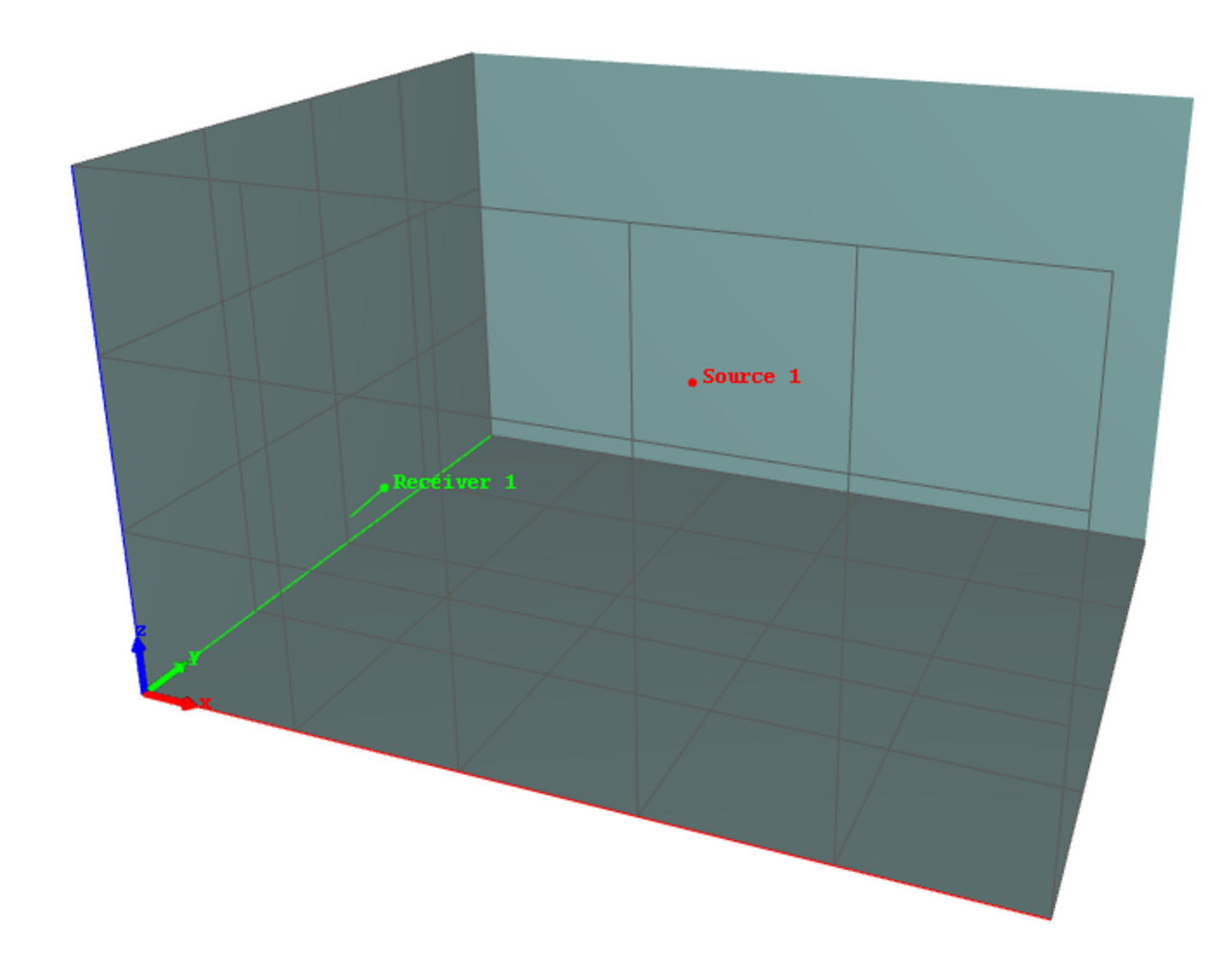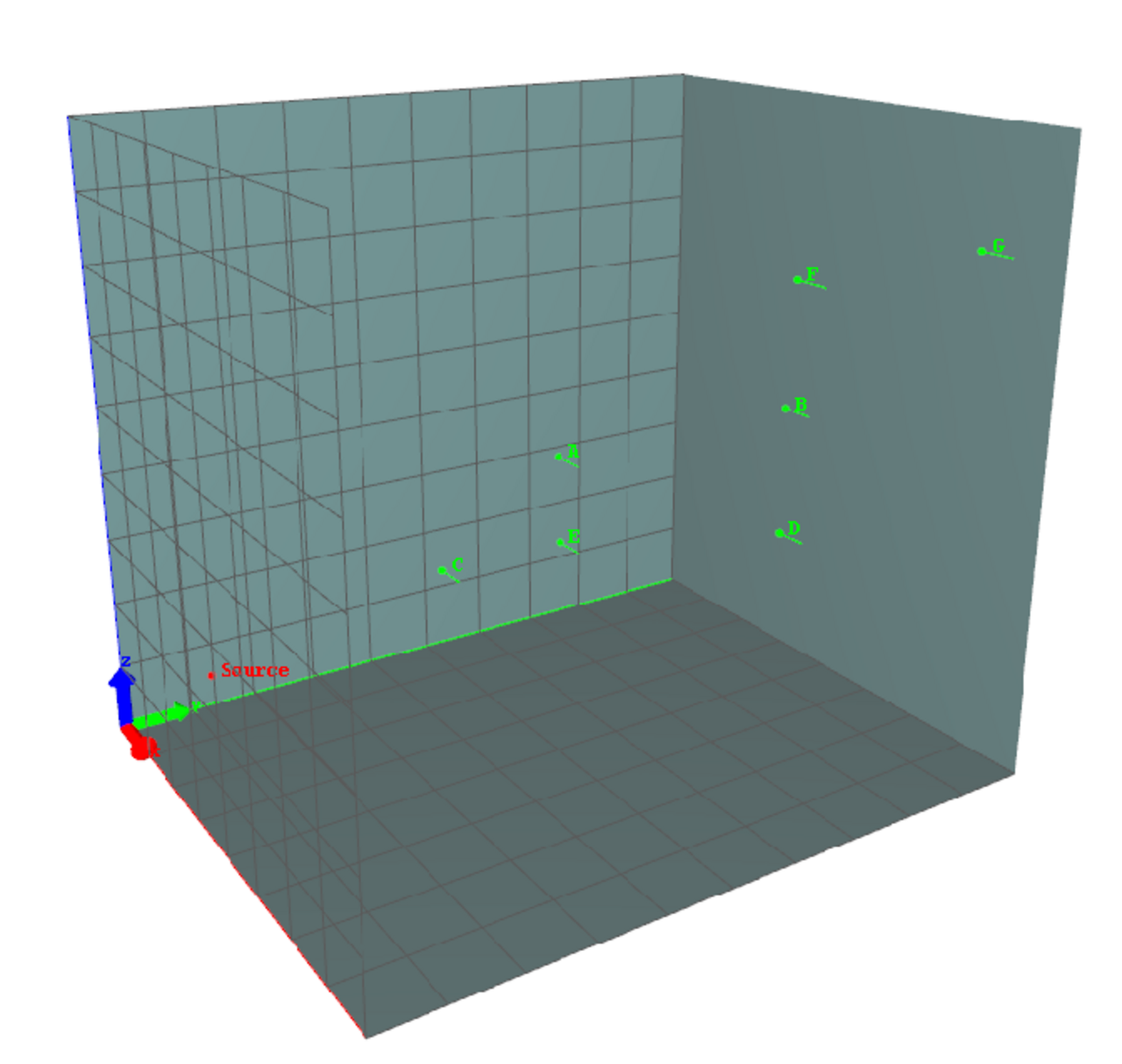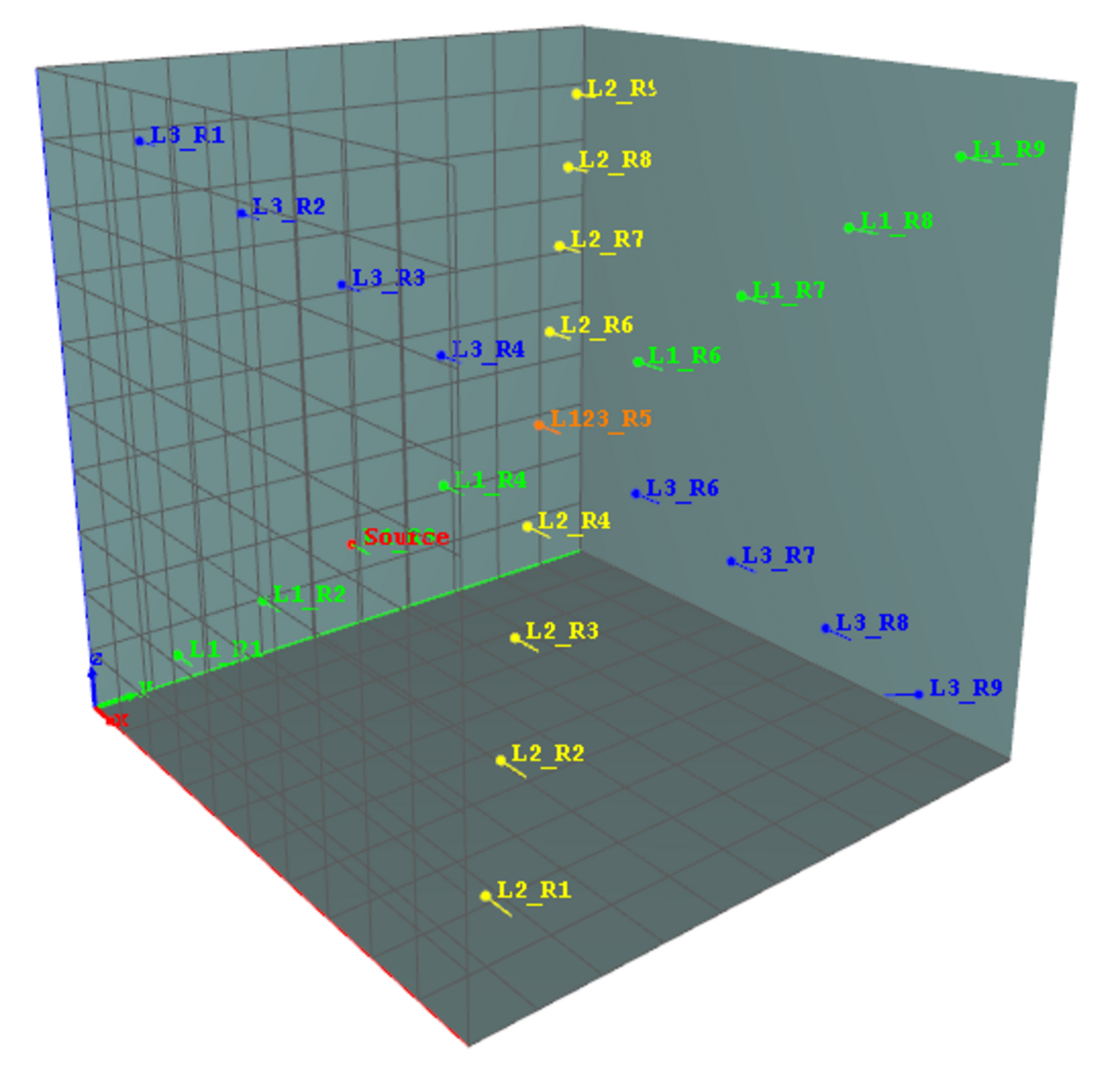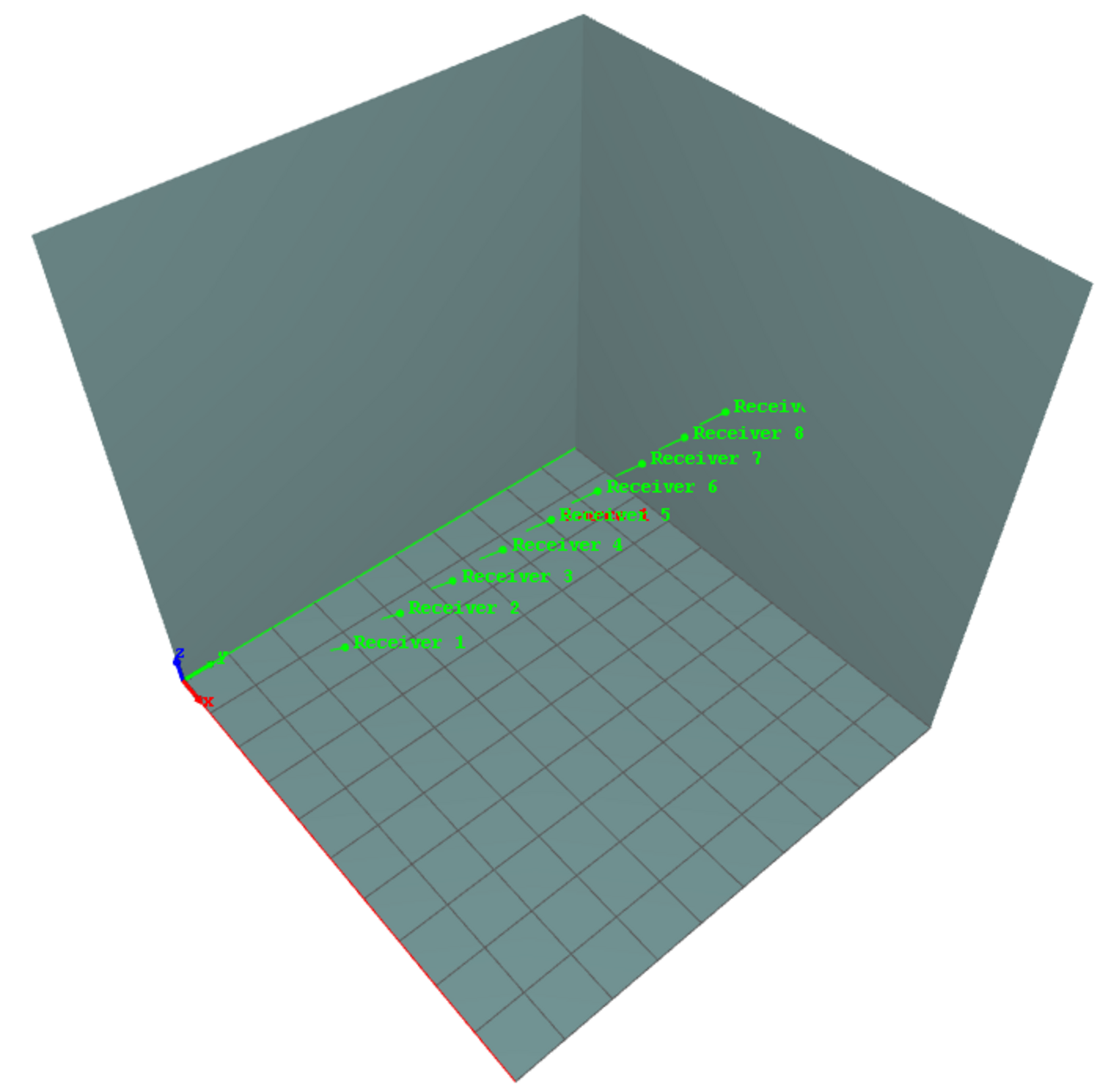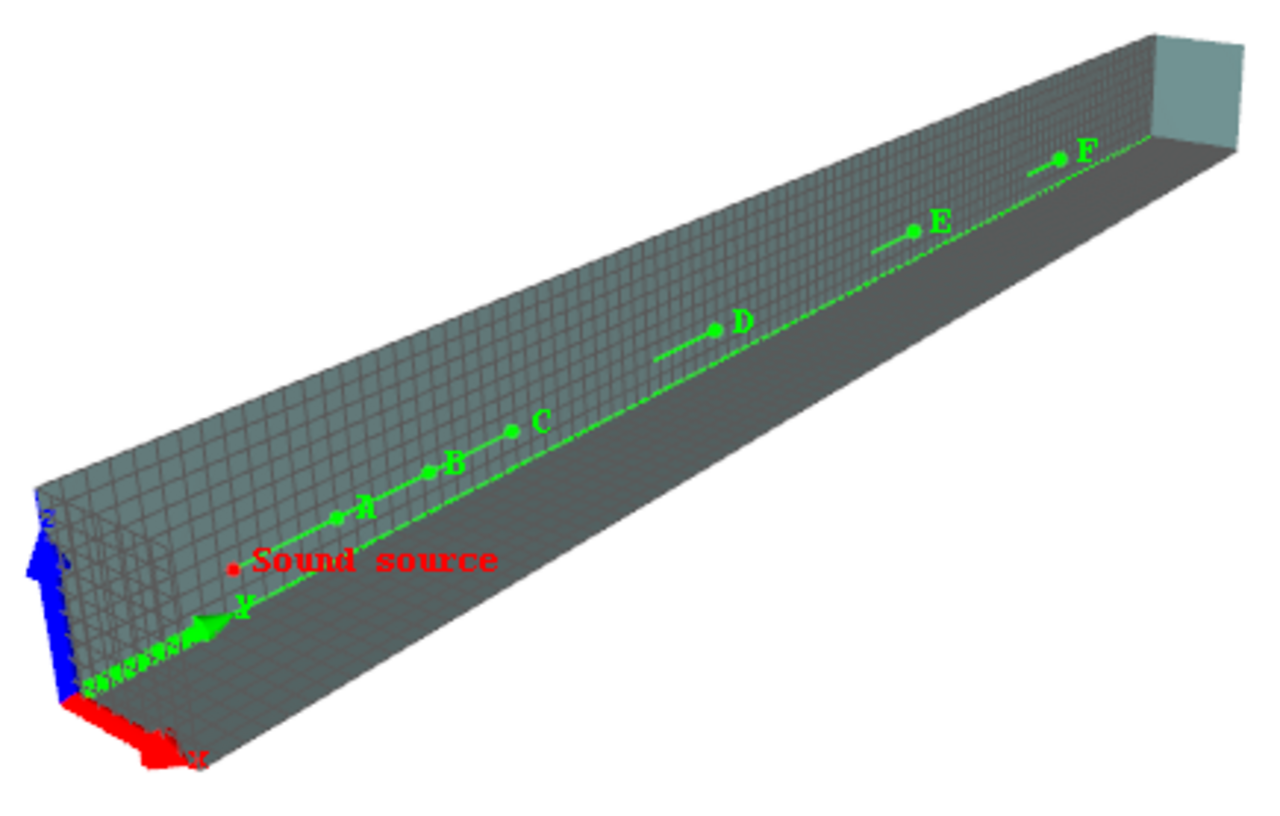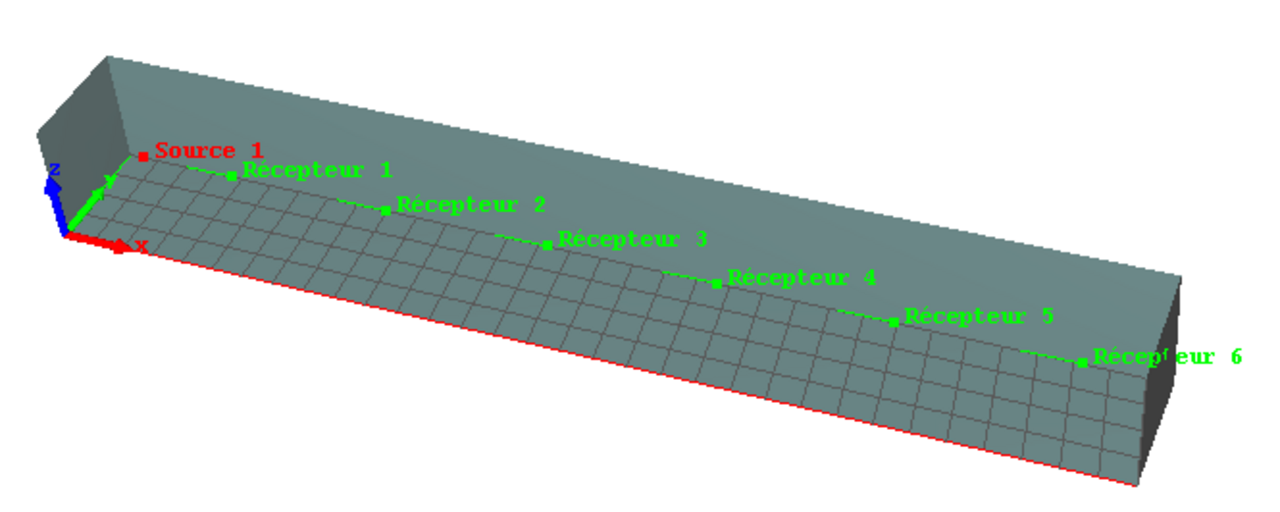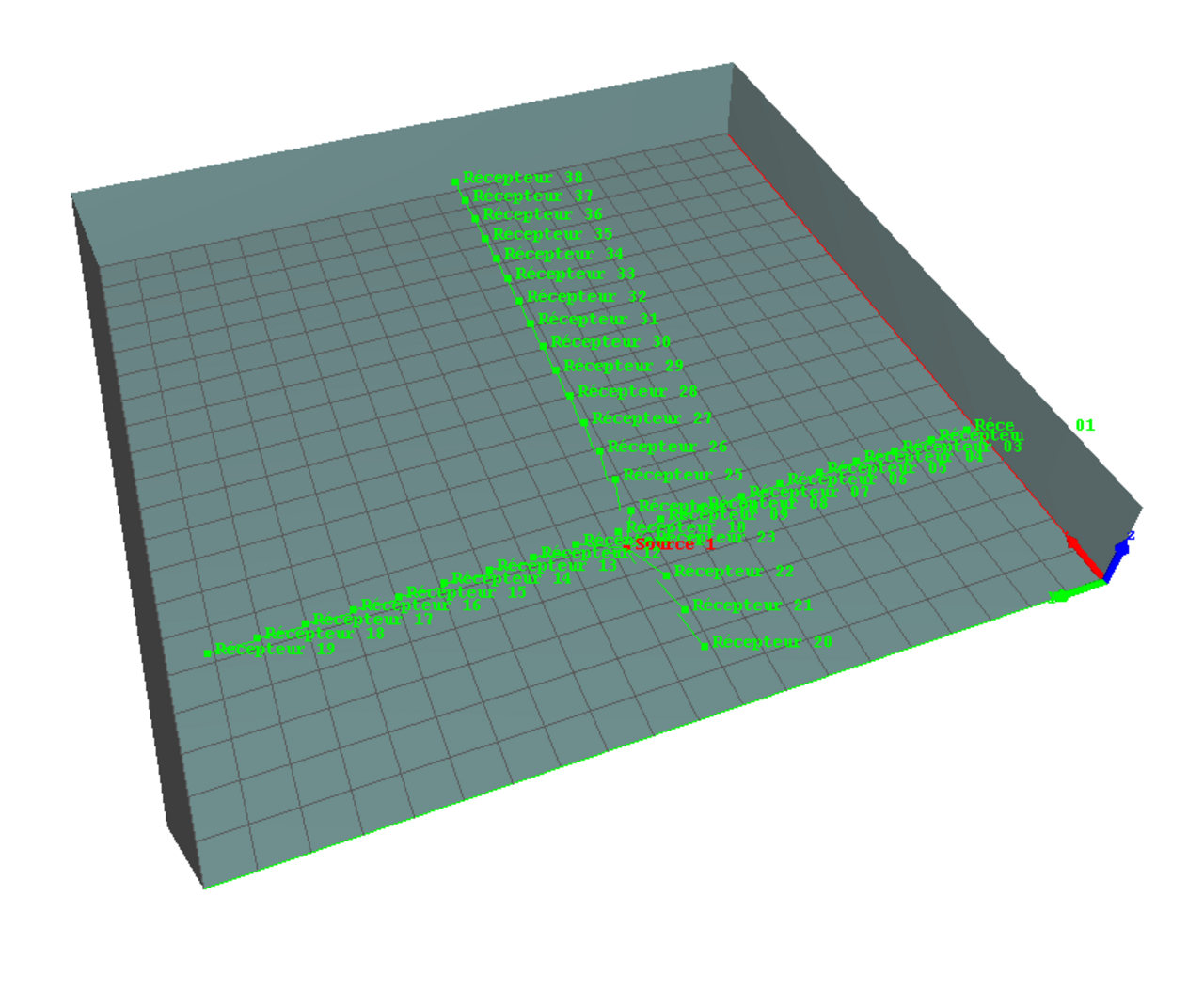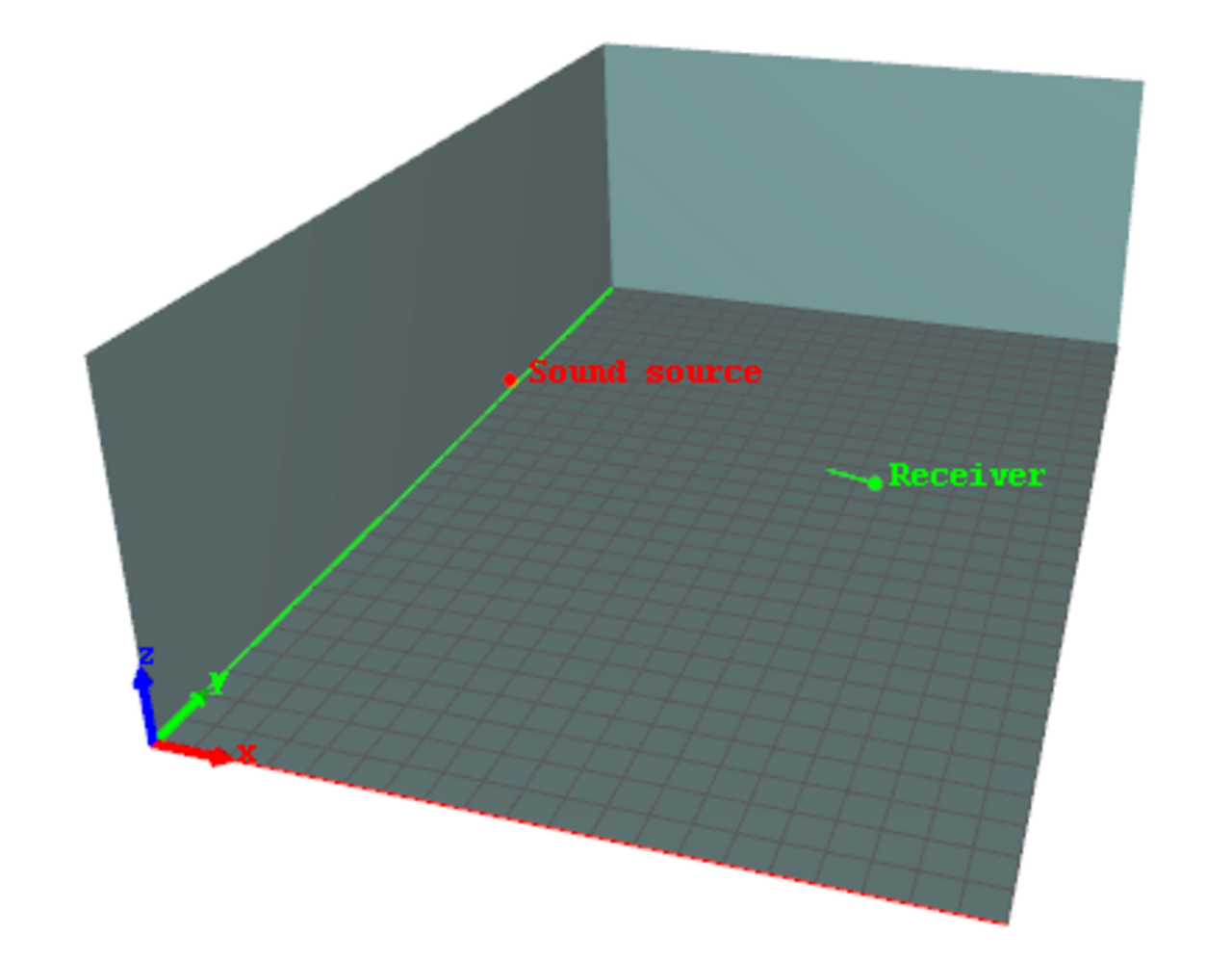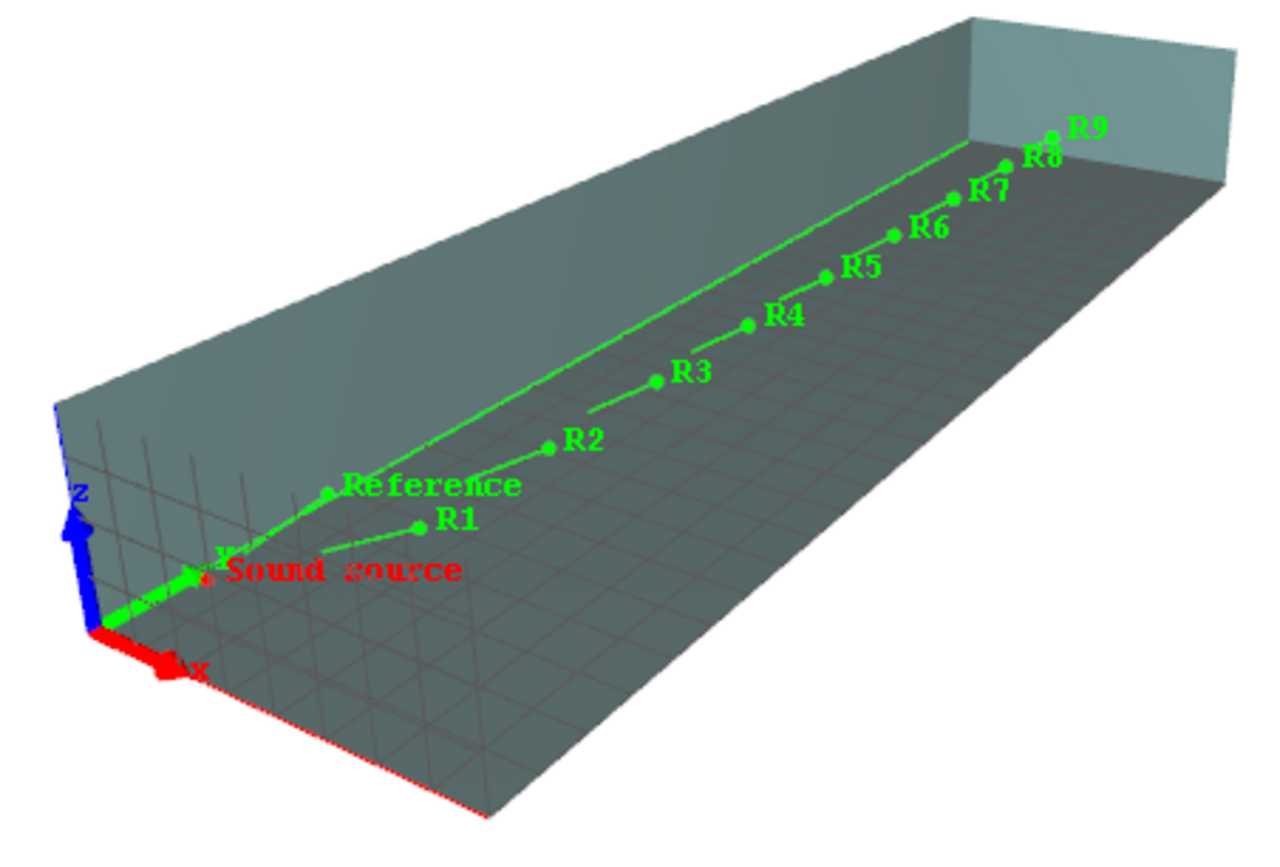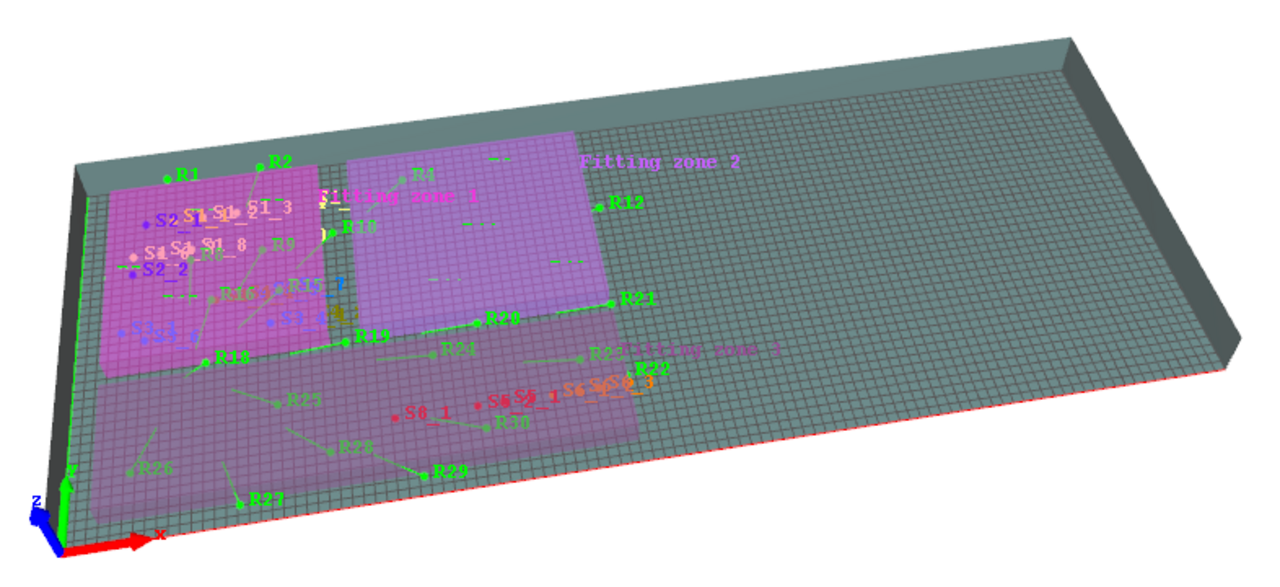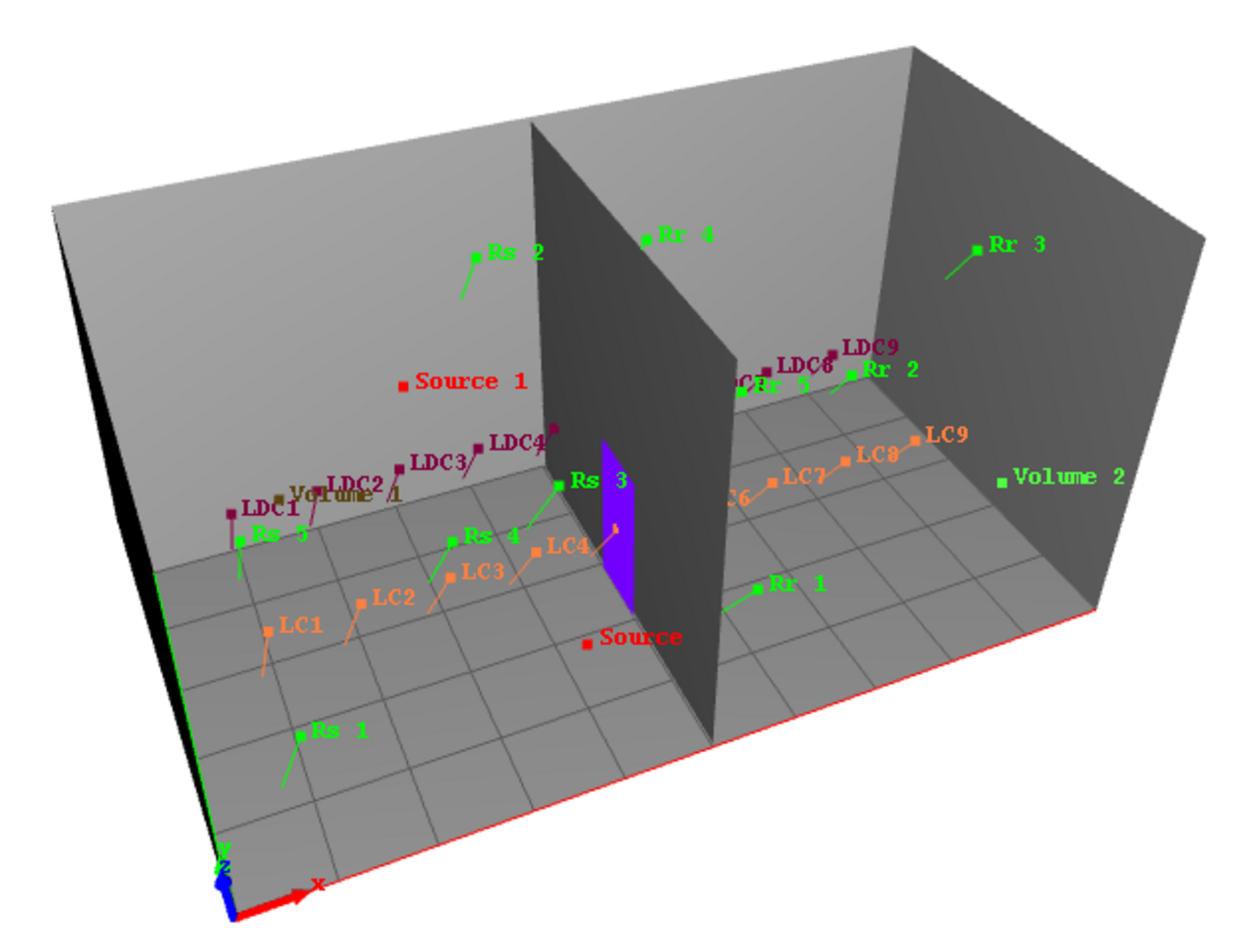All elements of this simulation are licensed under Licence Creative Commons Attribution 4.0 International License.
Code verification
In this section we propose few verification of the numerical codes that are proposed in I-Simpa. When possible, numerical simulations are compared to other models or data from the scientific literature.
- What is tested?
- What is tested?
- What is tested?
- What is tested?
- Description
- Description
- Description
- Description
- Code (copie 7)
- Code
- Code
- Code
- Reference
- Reference
- Reference
- CC-BY-SA
- Cubic room
- Long room
- Long room
- Quasi-cubic room
- What is tested?
- What is tested?
- What is tested?
- What is tested?
- What is tested?
- Description
- Code (copie 2)
- Description
- Code (copie 3)
- Description
- Code (copie 4)
- Description
- Code (copie 5)
- Description
- Code (copie 1)
- Reference
- Reference
- Reference
- Reference
- Reference
- Low room
- Low room
- Low room
- Low room
- Two coupled cubic room
- What is tested?
- Description
- Code (copie 1)
- Reference
- Low room
- What is tested?
- What is tested?
- What is tested?
- Description
- Description
- Code
- Description
- Code
- Reference
- Reference
- CC-BY-SA
- Cubic room
- Quasi-cubic room
- Long room
- Menu
- Caution
- Quasi-cubic room with diffuse reflection and atmospheric absorption [SPPS] [TCR] [MD]
- (copie 2)
- Quasi-cubic room with diffuse reflection and atmospheric absorption
- Quasi-cubic room with specular reflection and uniform absorption [SPPS] [TCR]
- Quasi-cubic room
- Cubic room with diffuse reflection and uniform absorption [SPPS] [TCR] [MD]
- Cubic room
- Cubic room with diffuse reflection and uniform absorption (0.1 and 0.5) [SPPS] [TCR] [MD]
- Cubic room with uniform absorption (0.1 and 0.5)
- Long room with specular reflection and uniform absorption [SPPS] [TCR]
- Long room
- Long room with diffuse reflection and uniform absorption [SPPS] [TCR] [MD]
- (copie 1)
- Long room with diffuse reflection and uniform absorption
- Low room with diffuse reflection and non-uniform absorption [SPPS] [TCR] [MD]
- (copie 1)
- Low room with diffuse reflection and uniform absorption (copie 2)
- Low room with mixed diffuse-specular reflection and non-uniform absorption [SPPS]
- Low room
- Low room with perfectly reflection and total ground absorption [SPPS]
- Low room
- Low room with non-uniform absorption (comparison with experimental data) [SPPS]
- Low room
- Industrial hall with non-uniform absorption and fitting objects (comparison with experimental data) [SPPS]
- Industrial hall
- Large industrial hall with non-uniform absorption, 3 fitting zones and 30 workplace (i.e. 30 receivers) [SPPS]
- Large industrial hall
- Two coupled cubic rooms with or without a door in a separation wall [SPPS] [MD]
- Two coupled cubic rooms with a separation wall
CAUTION - The following results present comparisons between numerical simulations carried out with I-Simpa and 'reference' data available in the scientific literature.
- It is difficult to prejudge the concept of 'reference'. The deviation between the simulations and the reference data that can be observed do not necessarily call into question the corresponding simulations but can also be associated with other sources of deviation (modeling assumptions, numerical instabilities, experimental uncertainties, etc.).
- Note also that these comparaisons can also show the limitations of some numerical codes.
Quasi-cubic room with diffuse reflection and atmospheric absorption [SPPS] [TCR] [MD]
Description
Academic case: Quasi cubic room (5m x 4m x 3m) with diffuse reflection (100%) and 10% uniform surface absorption, with a single source at the room center (100dB per each frequency band) and a receiver at location (1,1,1).
What is tested?
Comparison between TCR/SPPS/MD simulations in order to verify the implementation of the atmospheric absorption according to ISO 9613-1, and , in particular, the effect of air absorption on reverberation time.
ISO 9613-1:1993 Preview Acoustics -- Attenuation of sound during propagation outdoors -- Part 1: Calculation of the absorption of sound by the atmosphere
Quasi-cubic room with specular reflection and uniform absorption [SPPS] [TCR]
Description
Academic case: Quasi cubic room (8m x 10m x 9m) with specular reflection (no diffusion) and 10% uniform surface absorption, with a single source and 7 punctual receivers
All elements of this simulation are licensed under Licence Creative Commons Attribution 4.0 International License.
What is tested?
Comparison between simulations and results from the NORMAL code described in [Yang, 2000].
[Yang, 2000] L.N. Yang, B.M. Shield, Development of ray tracing computer model for the prediction of the sound field in long enclosures, Journal of Sound and Vibration, Volume 229, Issue 1, 2000, Pages 133-146, ISSN 0022-460X, dx.doi.org/10.1006/jsvi.1999.2477.
Cubic room with diffuse reflection and uniform absorption [SPPS] [TCR] [MD]
Description
Academic case: Cubic room (10m x 10m x 10m) with 100% diffuse reflection and 20% uniform surface absorption, with a single source at (3,3,3) and 3 lines of 9 punctual receivers along the 3 diagonals of the room.
All elements of this simulation are licensed under Licence Creative Commons Attribution 4.0 International License.
What is tested?
Comparison between I-Simpa simulations (TCR, SPPS, MD) and data from the radiosity method, as described in [Kang, 2002]. This allows to validate the modelling of the diffuse reflection in SPPS, as well, the behavior of the MD/TCR codes in an ideal diffuse sound field.
[Kang, 2002] Kang, Jian. Acoustics of Long Spaces: theory and design guidance. Thomas Telford, 2002. www.thomastelford.com/books/bookshop_main.asp;
Cubic room with diffuse reflection and uniform absorption (0.1 and 0.5) [SPPS] [TCR] [MD]
Description
Academic case: Cubic room (10m x 10m x 10m) with 100% diffuse reflection and 10% or 50% uniform surface absorption, with a single source at center and a line of 9 punctual receivers at locations (5,1:1:9,5).
All elements of this simulation are licensed under Licence Creative Commons Attribution 4.0 International License.
What is tested?
Comparison between I-Simpa simulations (TCR, SPPS, MD) using the geometry described in [Valeau, 2006]. This allows to compare numerical results in an ideal geometry for creating a diffuse sound field.
[Valeau, 2006] Valeau, V., Picaut, J., Hodgson, M. , "On the use of a diffusion equation for room-acoustic prediction", J. Acoust. Soc. Am. 119, 1504 (2006). doi.org/10.1121/1.2161433
Long room with specular reflection and uniform absorption [SPPS] [TCR]
Description
Academic case: Long room (8m x 100m x 9m) with specular reflection (no diffusion) and 10% uniform surface absorption, with a single source and 6 punctual receivers.
All elements of this simulation are licensed under Licence Creative Commons Attribution 4.0 International License.
What is tested?
Comparison between SPPS/TCR simulations and results from the NORMAL code described in [Yang, 2000].
[Yang, 2000] L.N. Yang, B.M. Shield, Development of ray tracing computer model for the prediction of the sound field in long enclosures, Journal of Sound and Vibration, Volume 229, Issue 1, 2000, Pages 133-146, ISSN 0022-460X, dx.doi.org/10.1006/jsvi.1999.2477.
Long room with diffuse reflection and uniform absorption [SPPS] [TCR] [MD]
Description
Academic case: Long room (32m x 4m x 4m) with 100% diffuse reflection and 10% uniform surface absorption, with a single source at (2,2,2) and a line of 6 punctual receivers at locations (2,5:5:30,2).
All elements of this simulation are licensed under Licence Creative Commons Attribution 4.0 International License.
What is tested?
Comparison between I-Simpa simulations (TCR, SPPS, MD) using the geometry described in [Valeau, 2006] and an external code (RAYSCAT). This allows to compare numerical results in a geometry that is not in agreement with the assumptions of a diffuse sound field.
[Valeau, 2006] Valeau, V., Picaut, J., Hodgson, M. , "On the use of a diffusion equation for room-acoustic prediction", J. Acoust. Soc. Am. 119, 1504 (2006). doi.org/10.1121/1.2161433
Low room with diffuse reflection and non-uniform absorption [SPPS] [TCR] [MD]
Description
Academic case: Low room (20m x 20m x 5m) with 100% diffuse reflection and non- uniform surface absorption 5% for all walls excepted at wall located at y=20m (absorption 50%), with a single source at (4,10,1) and two lines of 19 punctual receivers at locations at z=1m along x=4.5m (R1 to R19) and y=9.5m (R20 to R38) with a spatial step of 1m.
All elements of this simulation are licensed under Licence Creative Commons Attribution 4.0 International License.
What is tested?
Comparison between I-Simpa simulations (TCR, SPPS, MD) using the geometry described in [Valeau, 2006]. This allows to compare numerical results in a geometry that is not in agreement with the assumptions of a diffuse sound field (a low room with non-uniform absorption).
[Valeau, 2006] Valeau, V., Picaut, J., Hodgson, M. , "On the use of a diffusion equation for room-acoustic prediction", J. Acoust. Soc. Am. 119, 1504 (2006). doi.org/10.1121/1.2161433
Low room with mixed diffuse-specular reflection and non-uniform absorption [SPPS]
Description
Academic case: Low room (30m x 20m x 10m) with mixed reflection (varying scattering coefficient ) and non-uniform surface absorption, with a single source and 1 punctual receiver.
All elements of this simulation are licensed under Licence Creative Commons Attribution 4.0 International License.
What is tested?
Comparison between SPPS and the results obtained using a hybrid method (image-sources and radiosity) as described in [Korany, 2001].
[Korany, 2001] N. Korany, J. Blauert, O. Abdel Alim, Acoustic simulation of rooms with boundaries of partially specular reflectivity, Applied Acoustics, Volume 62, Issue 7, July 2001, Pages 875-887, ISSN 0003-682X, dx.doi.org/10.1016/S0003-682X(00)00075-X.
Low room with perfectly reflection and total ground absorption [SPPS]
Description
Academic case: Low room (30m x 20m x 10m) with perfeclty diffuse and reflecting surfaces, except the ground with a total absorption, with a single source and 1 punctual receiver.
All elements of this simulation are licensed under Licence Creative Commons Attribution 4.0 International License.
What is tested?
Comparison between SPPS and the results obtained using a hybrid method (image-sources and radiosity) as described in [Korany, 2001], for a room with total ground absorption.
[Korany, 2001] N. Korany, J. Blauert, O. Abdel Alim, Acoustic simulation of rooms with boundaries of partially specular reflectivity, Applied Acoustics, Volume 62, Issue 7, July 2001, Pages 875-887, ISSN 0003-682X, dx.doi.org/10.1016/S0003-682X(00)00075-X.
Low room with non-uniform absorption (comparison with experimental data) [SPPS]
Description
Low room (8m x 30m x 3.85m) with non-uniform absorption, with a single source, 7 receivers along a line and a reference receiver.
All elements of this simulation are licensed under Licence Creative Commons Attribution 4.0 International License.
What is tested?
Comparison between SPPS and experimental data from [Ondet, 1989].
[Ondet, 1989] Ondet, A. M. , and Barbry, J. L. (1989). “ Modeling of sound propagation in fitted workshop using ray tracing,” J. Acoust. Soc. Am. 85(2 ), 787–796. doi.org/10.1121/1.397551
Industrial hall with non-uniform absorption and fitting objects (comparison with experimental data) [SPPS]
Description
Industrial hall (8m x 30m x 3.85m) with non-uniform absorption, with a single source, 7 receivers along a line and a reference receiver. This simulation includes 3 configurations (B, C and D) with different size for the fitting zone (entire hall, left part, right part), each with specific fittings properties (mean free path and absorption).
All elements of this simulation are licensed under Licence Creative Commons Attribution 4.0 International License.
What is tested?
Comparison between SPPS and experimental data from [Ondet, 1989].
[Ondet, 1989] Ondet, A. M. , and Barbry, J. L. (1989). “ Modeling of sound propagation in fitted workshop using ray tracing,” J. Acoust. Soc. Am. 85(2 ), 787–796. doi.org/10.1121/1.397551
Large industrial hall with non-uniform absorption, 3 fitting zones and 30 workplace (i.e. 30 receivers) [SPPS]
Description
Very large industrial hall (107m x 42m x 5m) with non-uniform absorption, multiple sound sources (5 configurations: 1 (C1), 12 (C2), 22 (C3), 7 (C4) and 30 (C5) sound sources), 30 receivers. This simulation includes 3 fitting zones, with the same diffusion properties.
All elements of this simulation are licensed under Licence Creative Commons Attribution 4.0 International License.
What is tested?
Comparison between SPPS and experimental data from [Ondet, 1988]. Additional information concerning the experimentation are given in [Ondet, 1984].
[Ondet, 1988] A.M. Ondet, J.L. Barbry, Sound propagation in fitted rooms—comparison of different models, Journal of Sound and Vibration, Volume 125, Issue 1, 1988, Pages 137-149, ISSN 0022-460X, http://dx.doi.org/10.1016/0022-460X
[Ondet, 1984] A.M. Ondet, J.L. Barbry, Prediction of noise levels in fitted rooms. Note Scientifique et Technique No. 52, INRS October 1984 (1984) (in French)
Two coupled cubic rooms with or without a door in a separation wall [SPPS] [MD]
Description
Academic case: Comparison between SPPS and the classical theory of coupled rooms, for 2 cubic rooms (5m x 5m x 5m) [10% absorption, 100% diffusely reflecting] with or without a 1.8m² door (open, closed (no transmission) or R=10 dB) in a separation wall with an insertion loss R=10, 20, 30 dB
All elements of this simulation are licensed under Licence Creative Commons Attribution 4.0 International License.
What is tested?
Comparison between SPPS and theoretical results from the classical theory of reverberation applied to coupled rooms.

